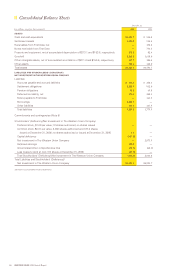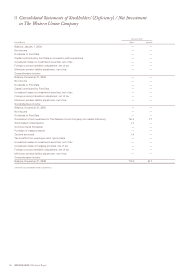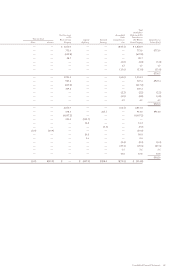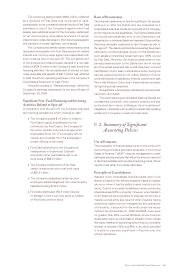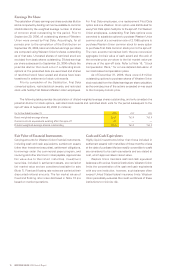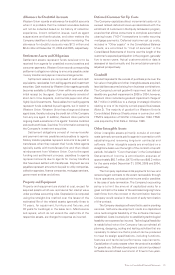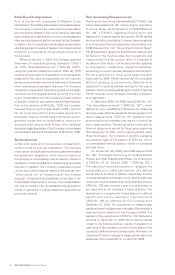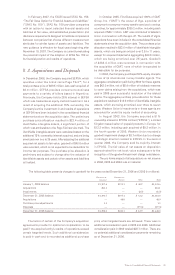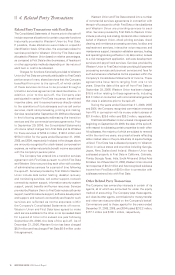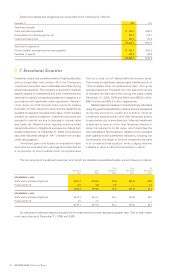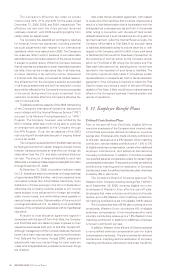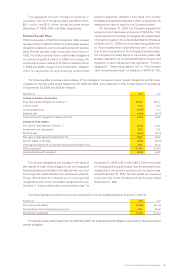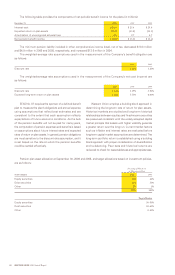Western Union 2006 Annual Report Download - page 76
Download and view the complete annual report
Please find page 76 of the 2006 Western Union annual report below. You can navigate through the pages in the report by either clicking on the pages listed below, or by using the keyword search tool below to find specific information within the annual report.WESTERN UNION 2006 Annual Report 74
Stock-Based Compensation
Prior to the spin-off, employees of Western Union
participated in First Data’s stock-based compensation plans.
The Company currently has a stock-based compensation
plan that grants Western Union stock options, restricted
stock awards and restricted stock units to employees and
other key individuals who perform services for the Company.
In addition, the Company has a stock-based compensation
plan that provides for grants of Western Union stock options
and stock unit awards to non-employee directors of
the Company.
Effective January 1, 2006, the Company adopted
Statement of Financial Accounting Standards (“SFAS”)
No. 123R, “Share-Based Payment” (“SFAS No. 123R”),
using the modified prospective method. SFAS No. 123R
requires all stock-based compensation to employees be
measured at fair value and expensed over the requisite
service period and also requires an estimate of forfeitures
when calculating compensation expense. The Company
recognizes compensation expense on awards on a straight-
line basis over the requisite service period for the entire
award. In accordance with the Company’s chosen method
of adoption, results for prior periods have not been adjusted.
Prior to the adoption of SFAS No. 123R, the Company
followed Accounting Principles Board (“APB”) Opinion
No. 25 which accounts for share-based payments to
employees using the intrinsic value method and, as such,
generally recognized no compensation expense for
employee stock options. Refer to Note 16 for additional
discussion regarding details of the Company’s stock-based
compensation plans and the adoption of SFAS No. 123R.
Reclassifications
Certain prior years amounts have been reclassified to
conform to the current year presentation. The Company
made certain reclassifications between settlement assets
and settlement obligations, which have no impact on
the Company’s consolidated financial position, results of
operations or cash provided from operations as previously
reported. In addition, the Company reclassified interest
income and interest expense related to third parties from
“Other income, net” to “Interest income” and “Interest
expense” to disclose them separately on the face of the
Consolidated Statements of Income. This reclassification
also had no impact on the consolidated financial position,
results of operations or cash provided from operations as
previously reported.
New Accounting Pronouncements
The Financial Accounting Standards Board (“FASB”) has
issued interpretation No. 48, “Accounting for Uncertainty
in Income Taxes—An Interpretation of FASB Statement
No. 109” (“FIN 48”), regarding accounting for, and
disclosure of, uncertain income tax positions. FIN 48 clarifies
the accounting for uncertainty in income taxes recognized
in an enterprise’s financial statements in accordance with
FASB Statement No. 109, “Accounting for Income Taxes.”
FIN 48 prescribes a recognition threshold and measurement
attribute for the financial statement recognition and
measurement of a tax position taken or expected to
be taken in a tax return. FIN 48 also provides guidance
on derecognition, classification, interest and penalties,
accounting for interim periods, disclosure and transition.
FIN 48 is effective for fiscal years beginning after
December 15, 2006. FIN 48 requires that the cumulative
effect of adopting its provisions be reflected as an
adjustment to opening retained earnings for the year of
adoption. We are currently evaluating the impact of adopting
FIN 48, however, we do not expect the effect of adoption
to be significant.
In September 2006, the FASB issued SFAS No. 157,
“Fair Value Measurements” (“SFAS No. 157”), which
defines fair value, establishes a framework for measuring
fair value under GAAP and expands disclosures about fair
value measurements. SFAS No. 157 applies to other
accounting pronouncements that require or permit fair
value measurements. The new guidance is effective for
financial statements issued for fiscal years beginning
after November 15, 2007, and for interim periods within
those fiscal years. The Company is currently evaluating
the potential impact of the adoption of SFAS No. 157 on
its consolidated financial position, results of operations
and cash flows.
On September 29, 2006, the FASB issued SFAS
No. 158, “Employers Accounting for Defined Benefit
Pension and Other Postretirement Plans—An Amendment
of SFAS No. 87, 88, 106 and 132(R)” (“SFAS No. 158”).
The statement requires employers to recognize the
overfunded and underfunded portion of a defined
benefit plan as an asset or liability, respectively, and any
unrecognized gains and losses or prior service costs as a
component of accumulated other comprehensive income.
SFAS No. 158 also requires a plan’s funded status to
be measured at the employer’s fiscal year-end. The
requirement to recognize the funded status of a defined
benefit plan and the disclosure requirements of
SFAS No. 158 are effective for the Company as of
December 31, 2006. The requirement to measure plan
assets and benefit obligations as of the date of the employer’s
fiscal year end is effective for the Company in 2008. The
adoption of the requirements of SFAS No. 158 that became
effective on December 31, 2006 did not have a material
impact to the financial position, results of operations or
cash flows of the Company due to the frozen status of the
Company’s defined benefit pension plans. However, the
Company will need to change its measurement date from
September 30 to December 31 no later than 2008.


